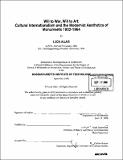Will to war, will to art : cultural internationalism and the modernist aesthetics of monuments, 1932-1964
Author(s)
Allais, Lucia
DownloadFull printable version (192.9Mb)
Alternative title
Cultural internationalism and the modernist aesthetics of monuments, 1932-1964
Other Contributors
Massachusetts Institute of Technology. Dept. of Architecture.
Advisor
Mark Jarzombek.
Terms of use
Metadata
Show full item recordAbstract
This dissertation examines a period around World War II when the prospect of widespread destruction provoked a profound re-evaluation of Europe's landmarks, their material value, and their ethical significance. Between 1932 and 1964, works once known as artistic and historic monuments-from buildings to bridges, paintings to shrines, ruins to colossi-acquired a "cultural" value as belonging to the "universal heritage of mankind." Promoted as didactic objects of international understanding, they became subjects of a new brand of international law. I trace the origins of this international valuation to a political movement, identified as Cultural Internationalism, whose main tenet was that the transnational circulation of knowledge constitutes an antidote to war. This ideal fueled the birth of organizations that brandished the autonomy of intellectual work as a weapon against nationalisms: most visibly, the League of Nations' Institut International de Coop&ation Intellectuelle (IICI, 1924-1941), its successor the United Nations Educational, Cultural, and Scientific Organization (UNESCO, 1946-), and the American Commission for the Protection and Salvage of Artistic Monuments in War Area (Roberts Commission, 1943-46). Despite the continued role of this institutional lineage in cultural production worldwide, there has not been a study of its contribution to 20th-Century aesthetics. (cont.) The dissertation explores the modernist aesthetics of monuments that arose from this milieu and unfolded in three related fields: the bombed cities of the Allies' war, the architecture of the European reconstruction, and the heritage missions of the decolonization. A broad network of intellectuals, art historians, architects, and archaeologists was enlisted to show that monuments gave iconic weight to cultural autonomy in a new world order. I follow these experts' attempts to effect this autonomy: working in conferences and as field experts, spawning an intricate network of civilian and military committees, caring for a growing collection of monuments, and encountering the shifting winds of a massive geo-political realignment.
Description
Thesis (Ph. D.)--Massachusetts Institute of Technology, Dept. of Architecture, 2008. "September 2008." Includes bibliographical references (p. [511]-535).
Date issued
2008Department
Massachusetts Institute of Technology. Department of ArchitecturePublisher
Massachusetts Institute of Technology
Keywords
Architecture.